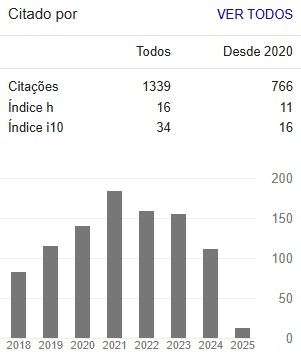Percutaneous closure versus surgical ostium secundum atrial septal defect: An integrative review
Keywords:
Atrial septal defect, ostium secundum, percutaneous treatment, surgery, anatomical variationAbstract
Atrial septal defect (ASD) represents about 5% to 10% of all diagnosed congenital heart diseases, it is more common in women, with a prevalence of 1.5 to 3.5 women for each man. Changes in the interatrial septum in the oval fossa are called ostium secundum interatrial communication, which correspond to 75% of all ASD cases. Half of the defects are resolved spontaneously while the other half requires surgical of percutaneous intervention. Although the surgical approach has been used for many years, the development of percutaneous techniques has allowed the transcatheter closure of the ASD ostium secundum with excellent results in short and long terms. However, the wide anatomical variation of ASD can compromise the results of percutaneous treatment. Therefore, an integrative review was carried out in order to compare the surgical and percutaneous closure of ASD ostium secundum pointing out the benefits and complications of both techniques. The results showed that as for effectiveness, safety and mortality, both techniques are equally comparable but the complication rates and reduced hospitalization of percutaneous treatment justifies its indication as the method of choice for the treatment of ASD ostium secundum.
Downloads
References
Cardoso CO, Rossi Filho RI, Machado PR, François LMG, Horowitz ESK, Sarmento-Leite R. Efetividade da Prótese de Amplatzer® para Fechamento Percutâneo do Defeito do Septo interatrial tipo ostium secundum. Arq Bras Cardiol 2007;88(4):384-389. DOI: https://doi.org/10.1590/S0066-782X2007000400003
Ribeiro MS, Costa RN, Pedra SRFF, Kreuzig DL, Fontes VF. Estado atual do tratamento dos defeitos do septo atrial. Rev Soc Cardiol Estado de São Paulo 2017;27(1):39–48. DOI: https://doi.org/10.29381/0103-8559/2017270139-48
Pedra CAC,Pedra SRF, Fontes VF. Comunicação interatrial do tipo ostium secundum. Do tratamento cirúrgico ao percutâneo e os dinossauros do futuro. Arq Bras Cardiol, 2003;80(6):650-5. DOI: https://doi.org/10.1590/S0066-782X2003000600010
Rao PS, Harris AD. Recent advances in managing septal defects: atrial septal defects. F1000Res. 2017;22;6:2042. DOI: https://doi.org/10.12688/f1000research.11844.1
Silveira AC, Rached EB, Campane FZ, Maielo JR. Comunicação interatrial. Rev. Fac. Ciênc. Méd. Sorocaba. 2008;10(2):7-11.
Naqvi N, McCarthy KP, Ho SY. Anatomy of the atrial septum and interatrial communications. J Thorac Dis. 2018 Sep;10(Suppl 24):S2837-S2847. DOI: https://doi.org/10.21037/jtd.2018.02.18
Alal Z, Hascoët S, Gronier C, Godart F, Mauri L, Dauphin C, Lefort B et al. Long-Term Outcomes After Percutaneous Closure of Ostium Secundum Atrial Septal Defect in the Young: A Nationwide Cohort Study. JACC Cardiovasc Interv. 2018 Apr 23;11(8):795-804. DOI: https://doi.org/10.1016/j.jcin.2018.01.262
Hajizeinali A, Sadeghian H, Rezvanfard M, Alidoosti M, Zoroufian A, Volman MA. A comparison between size of the occluder device and two-dimensional transoesophageal echocardiographic sizing of the ostium secundum atrial septal defect. Cardiovasc J Afr. 2013 Jun;24(5):161-4. DOI: https://doi.org/10.5830/CVJA-2013-014
Ursi ES. Prevenção de lesões de pele no perioperatório: revisão integrativa da literatura. [dissertação]. Ribeirão Preto: Universidade de São Paulo, Escola de Enfermagem de Ribeirão Preto; 2005.
Da Costa RN, Ribeiro MS, Pereira FL, Pedra SRF, Jatene MB, Jatene IB et al. Fechamento percutâneo versus cirúrgico da comunicação interatrial em crianças e adolescentes. Arq Bras Cardiol. 2013;100(4):347-354.
DOI: https://doi.org/10.5935/abc.20130059
Hoashi T, Yazaki S, Kagisaki K, Kitano M, Kubota SM, Shiraishi I, et al. Management of ostium secundum atrial septal defect in the era of percutaneous trans-catheter device closure: 7-Year experience at a single institution. J Cardiol. 2015 May;65(5):418-22. doi: https://doi.org/10.1016/j.jjcc.2014.07.009
Thingnam SKS, Mahajan S, Kumar V. Surgical perspective of percutaneous device closure of atrial septal defect. Asian Cardiovasc Thorac Ann. 2018 Jun;26(5):343-346. DOI: https://doi.org/10.1177/0218492318776568
Pillai AA, Sinouvassalou S, Jagadessan KS, Munuswamy H. Spectrum of morphological abnormalities and treatment outcomes in ostium secundum type of atrial septal defects: Single center experience in >500 cases. J Saudi Heart Assoc. 2019 Jan;31(1):12-23. DOI: https://doi.org/10.1016/j.jsha.2018.09.002
Downloads
Published
Issue
Section
License
Os artigos submetidos à revista Colloquium Vitae estão licenciados conforme CC BY-NC-ND. Para mais informações sobre essa forma de Licenciamento, consulte: http://creativecommons.org/licenses/by-nc-nd/4.0/.
A disponibilização é gratuita na Internet, para que os usuários possam ler, fazer download, copiar, distribuir, imprimir, pesquisar ou referenciar o texto integral dos documentos, processá-los para indexação, utilizá-los como dados de entrada de programas para softwares, ou usá-los para qualquer outro propósito legal, sem barreira financeira, legal ou técnica.

